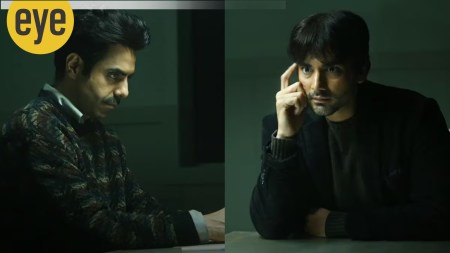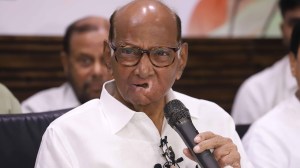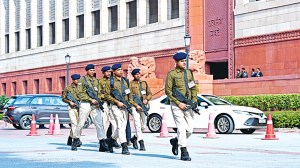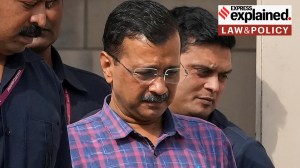- India
- International
‘Only 9% of Aarey is to be used for development’, says V K Phatak
V K Phatak has played a key role in drafting Mumbai’s new Development Plan 2014-2034, as advisor to BMC.
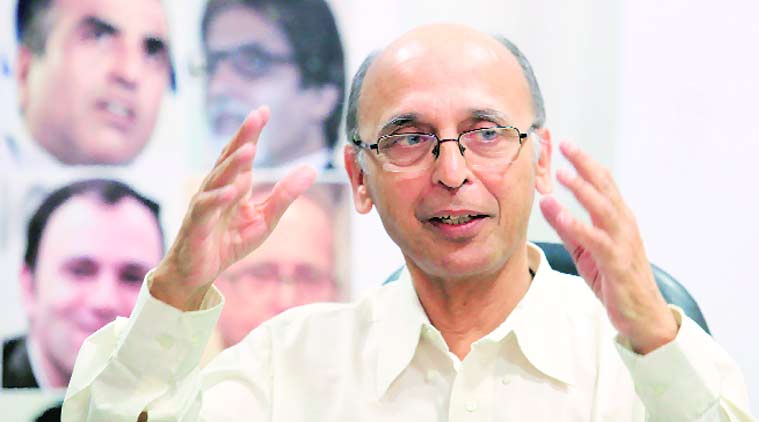 It is obvious that we have more population that is demanding more floor space (FSI) and we cannot expand more. Once FSI became a scarce commodity, government started using it for so-called “social purposes”. (Source: Express Photo by Ganesh Shirsekar)
It is obvious that we have more population that is demanding more floor space (FSI) and we cannot expand more. Once FSI became a scarce commodity, government started using it for so-called “social purposes”. (Source: Express Photo by Ganesh Shirsekar)Urban planner and former chief town planner with the MMRDA, V K Phatak has played a key role in drafting Mumbai’s new Development Plan 2014-2034, as advisor to the Brihanmumbai Municipal Corporation. In this Idea Exchange, he talks about the need to change the way land is obtained for public purposes, on the contentious hike in FSI and on balancing development and open spaces
Kavitha Iyer: Is there any hope that the percentage of implementation will increase with this Development Plan as compared to the previous plans?
Yes, and that is because of the pragmatism of the plan. Instead of making specific reservations in this plan for schools, hospitals etc, we have limited the reservations for major facilities only. The previous plan had strange calculations wherein, for example the Juhu airport was marked as a park and the cotton textile markets were marked as gardens with the hope that these will shift to Bandra-Kurla Complex. We have moved away from this location-specific reservation. The way of obtaining land for public purpose has to be changed. What we have suggested is that any development on a plot more than 2,000 square metres should contribute 10 per cent of the plot to BMC, which will in turn create a pool of land for public utilities. This land can be put for specific use as per the local needs of the area. This process will become more democratised and participatory over the years.
Shalini Nair: This was the first time that consultative workshops were held by BMC before drafting the DP. However, every citizen group that was involved have objected to the draft saying none of their suggestions has been taken into consideration. What went wrong?
Every suggestion made by groups could not be included. It is as simple as that. For example, in case of garden reservations on slums, people working for their rehabilitation were keen that it gets deleted, however, people working for open spaces wanted the reservation to be intact. DP is just a framework, it cannot take an aggressive stand because BMC is not going to create funds for it.
Tanushree Venkatraman: In case of affordable housing, BMC has maintained that it is taking the plain economic approach of increasing the supply of houses to meet the market demand. But how practical a consideration is this?
There is a distinct provision for inclusionary housing. Wherever the plot size is more than 2,000 square meters, 10 per cent in addition to the base FSI will have to be given in the form of small units, which have to be given free of cost to BMC. Civic body can then use it in the form of rental space, small units for project affected persons etc.
Shalini Nair: But isn’t that a dilution of the existing norms which say that 20 per cent should be reserved for public purpose?
That 20 per cent was at an FSI of 1, but the base FSI is 2.5. And that was for a plot size of 4,000 square meters, we have reduced the size of the plot also.

Tabassum Barnagarwala: There are a lot of international cities which are growing horizontally. Can’t that be a solution for open spaces or the increasing space crunch in the city?
It could have been a solution. Historically, Mumbai grew the same way. When FSI of 1 was introduced in 1967, a lot of land was reclaimed in the city. But that option disappeared from 1991 because of CRZ norms. The wetlands are also covered by mangroves, which have added one more layer of environmental norms to be followed.
Shalini Nair: The decision to increase FSI has drawn a lot of flak. What purpose will it serve apart from increasing the scope for manipulation?
This thought stems from the notion that what was earlier prescribed for FSI was right. When FSI was introduced in 1967, it varied among areas. For instance Ballard Estate, Marine Drive had a FSI of 2.45 which was already in existence. But areas like Kalbadevi were assigned 1.66 when it was already at 3 or 4. The notion was changed from 1977 when the concept was to control growth and density, so FSI was flattened to 1.33 and 1. The population target in the 1991 DP was 9.8 million by 2001, but actual population reached 11 million. It is obvious that we have more population that is demanding more floor space and we cannot expand more. Once FSI became a scarce commodity, government started using it for so-called “social purposes”. So slums, cess buildings, IT industry, hotels, schools, hospitals and relocation of cattle sheds had to be helped with extra FSI. For the government, these are off-budget schemes that don’t require funds but the burden is then on the markets. So from 1997, if a person bought an apartment, he was buying his own house and three slum dwellers’ units.
Shalini Nair: But in the case of mill lands, though FSI was raised, the prices never came down. Unless you index FSI to creating of affordable housing, how will you create it?
Affordable housing is a different subject, it cannot be achieved by restricting FSI. Even if you relax FSI, people who have money will buy bigger houses, and even if the prices come down, people can buy more houses. FSI itself will not solve the problem. Excessive intervention in the market is not the solution, one should accept it, and not distort it because it can create problems in governance.
Mihika Basu: The new DP is more pragmatic in its approach, but it has incorporated restricted zones in areas like BARC in open spaces. What was the rationale behind this?
That has been changed. If you see the latest version. BARC is not been counted as open spaces. They were mentioned that apart from the land which is publicly available as part of the recreational area, there are these kinds of spaces like the Raj Bhavan, University, TISS, IIT, they were not counted as publicly open spaces. That paragraph had been changed, before it was formally published.
Manasi Phadke: A lot of political parties have spoken against the DP, including parties like the Shiv Sena and BJP, which are ruling in the BMC. What is the extent of their involvement during the drafting of the DP, and what do you make out of this reaction?
Drafting there was not much involvement, but during the process like the preparatory studies were given to individual political parties and in terms of making presentation and letting them know what is the approach the DP wants to take, the issues that were identified, was all presented to them.
Tanushree Venkatraman: Open spaces allocation has been drastically lower as compared to all the standards, be it international or our own goals, is there another way of looking at this or solving this issue?
The problem is that Mumbai cannot expand horizontally, partly because of the scene around and also because of the CRZ is restrictive. This can be overcome in other cities as the other cities have no boundaries like Hyderabad or Ahmedabad or Pune. It could have been overcome by expanding the public transit network which can open up to new areas for development. This is just how Mumbai grew along the railway. That is how Navi Mumbai grew after the railways were put in. This is essentially a public transit city.
Apart from Navi Mumbai which grew parallel to the railway, efforts to improve the railways since then have been to improve on the existing corridor like quadrapling the railways existing between Borivali and Virar. It is not opening up new areas. It might probably help density wise in that area because no facilities are available. The density has reached a saturation point so they need to open up new areas.
So far that has not happened. Even the metros are within Greater Mumbai they would not help in plans to expansion as far as Mumbai housing market is concerned. There is a need to look at investment in transport as a way of opening land a way for expanding the housing market and that would be at a regional stage and cannot addressed in the DP.
Tanushree Venkatraman: Aarey has become a huge point of contention. What is the rationale behind converting a huge green space into an economic hub when the city is already starved for open spaces?
Leave the details behind. Looking at it historically, Ballard Estate was one of the earliest business centres. Then in the 1970s we have Nariman Point where the private offices could get a foothold and develop. Then we had BKC. In all the three places, government-owned land played a key role in terms of creating a focus for development in the new emerging economic activity. In the next 20 years, is Mumbai going to get such an opportunity? If at all it does get such opportunities, then where would it go?
For instance, take the State Bank of India. It started at Horniman circle, then to Nariman point then to BKC. Such kind of things are required in the cities like this. It creates fertile ground for new economic activities to emerge and the old economic activities are recycled. To maintain this cycle we need to strategically use publicly owned land. You are not going to get an opportunity to get private land into public ownership and use that. Today Aarey is not the Aarey of 25 years ago. Things have grown sporadically in a haphazard manner, plus the slums. This is one opportunity to address those future needs. Other things is what we have lost as opportunities. The Indian School of Business went to Hyderabad, and the Indian Institute of Human Settlements went to Bangalore.
Mumbai, surprisingly has no planning school. Large institutions, which require large land, have no options in Mumbai. So, whether Aarey could be used for that purpose is another question. What we have said is that the 4-5 per cent of available Aarey land be for these institutions depending on how we design it. Another 4-5 per cent land assuming that Metro Line III is going to terminate there, you might as well use for commercial purposes for bringing revenues, in addition to roads and other access areas created. Hence, together with all these things about 9 per cent could be used for commercial exploitation purposes.
Manasi Phadke: How much of the previous DP was implemented?
Thirty-five per cent of it was implemented but part of it was accommodation reservation. Say an entire plot of 200 sq. meters; where one section is reserved for a municipal school but has not been made but you would still include it as implemented, hence, the total is a bit exaggerated in terms of how much has been implemented.
(Transcribed by Tanushree Venkatraman, Meghna Yelluru and Rohit Alok)
Buzzing Now
May 11: Latest News
- 01
- 02
- 03
- 04
- 05


